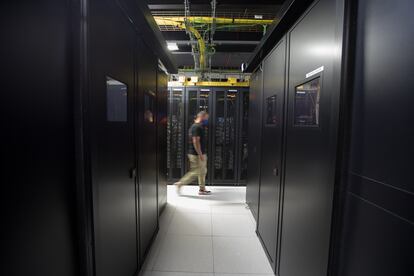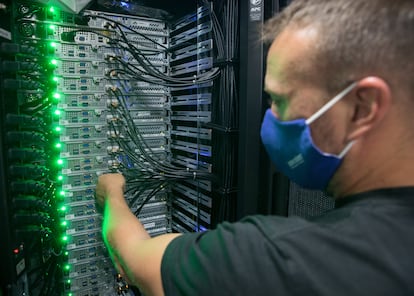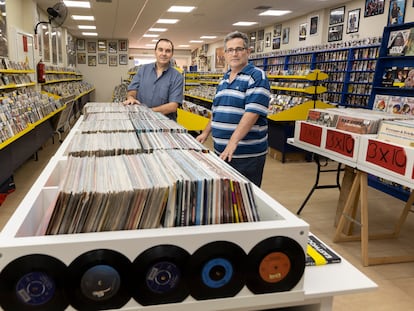Why our online lives in Spain must take an obligatory route through Madrid
An ageing industrial park in the capital is the unlikely location for the data centers that host servers for digital giants such as Facebook, Google and Netflix. Could a rebranding help the area get a new lease of life?


At first glance no one would think that the Julián Camarillo industrial park, in the Madrid district of San Blas, would be the area with the most internet traffic in the whole Iberian peninsula. In this northeastern neighborhood of the capital, cars double park in front of automobile repair shops and the place is deserted after dark, with few sounds apart from the Latin music drifting from a dance school and the dull thuds emanating from a couple of boxing clubs.
But the Julián Camarillo park is also the headquarters of the data centers where Netflix, Amazon, Facebook, Google and Disney house their servers. “Around 65% of the internet data that circulates in Spain and Portugal comes through here,” says Robert Assink, the managing director in Spain of the Dutch multinational Interxion, a giant in the data center sector.
The seemingly nondescript buildings in the vicinity have aroused little interest over the past 20 years. But new technologies, such as 5G, augmented reality and autonomous vehicles, have boosted the need for storage, making data centers a crucial piece of infrastructure for the digital economy.
Interxion is currently setting up the largest data center in Madrid here. It measures 35,000 square meters spread over four floors and will stand on the abandoned site once occupied by the slot machine manufacturer, Recreativos Franco. Like all data centers, it will be a large refrigerator for computers, which will be placed under seven layers of security with protective measures against catastrophes. For everything to work, it is necessary to keep the center cold and avoid mishaps. If anything were to happen to these machines, Spain would grind to a halt.

Due to the evolution of the internet, investment funds have developed a voracious appetite for plowing money into data centers. This interest has turned Julián Camarillo into an “area with enormous growth potential,” according to London-based real estate consultants, Knight Frank. Meanwhile, the US real estate consultancy firm CBRE dubs it a “relevant area of Madrid” that is experiencing “real estate dynamism.” To optimize the area’s appeal, a group of real estate entrepreneurs have proposed it be rechristened Madbit, in a bid to attract an ecosystem of technology companies, as Silicon Valley does. “We have already met with the mayor [José Luis Martínez Almeida] and he’s fine with the new name,” says Juan Barba, president of the Madbit association. The idea of re-branding the zone mirrors Barcelona’s renaming of the former industrial neighborhood of Poblenou, District @22, which is now considered the most techie neighborhood in Spain.
The councilor for innovation in Madrid, Ángel Niño, confirmed to EL PAÍS that City Hall is indeed considering the suggestion. “We are open to evaluating the proposal officially and to working for its possible implementation,” he said. If the initiative succeeds, the big loser would be Julián Camarillo, an investor who promoted the urbanization of the east of Madrid at the beginning of the 20th century. As a consolation prize, his name would remain on a street that runs through the industrial park.
The golden mile of data centers
The neighborhood has the ideal conditions to become the golden mile of data centers, according to real estate and IT experts: good connectivity to the country’s fiber-optic backbone, a ring of main highways around it; access to significant electrical power needed to cool the servers; and proximity to a large mass of users – it is eight kilometers from Madrid’s central point, the Puerta del Sol.
This last factor is essential for the users of new internet technologies, explains IT architecture specialist Ignacio Llorente. The key is latency, the delay between the click and the visual or audio response. When it comes to looking at a website, it doesn’t matter if the servers have a slight delay on account of being located further afield, but a self-driving car can’t wait one second for information to arrive from a server in Tokyo.
“In augmented reality or autonomous driving, there should be a latency of one or two milliseconds at most,” says Llorente, CEO of data center software company OpenNebula. “That’s only possible with data centers close to the user. If it’s more, it’s no good.” The significant latency of servers located at a distance from users happens because data cannot travel faster than the speed of light. For example, it usually takes about 40 milliseconds to receive information from Paris.
Spain, like the rest of the developed world, is experiencing a boom in data centers. The industry’s fledgling association, Spain DC, forecasts an investment of €5 billion over the next five years. The sector, which uses electrical capacity as a means of measurement, now has some 200 megawatts of power installed throughout Spain and expects to reach 500 megawatts in the next year and a half.
The two main data-center hubs in Madrid are in Julián Camarillo and Alcobendas. Spain DC foresees that future projects will be installed not only in these two hubs, but also in the whole northeast zone, around the A-1 and A-2 highways, because this area can connect the traffic from submarine cables landing at the Spanish and Portuguese coasts. According to Llorente, any location within the metropolitan area of Madrid would be optimal as none would exceed the threshold of one or two milliseconds.
Interxion’s new data center in the Julián Camarillo industrial estate is a very expensive building that will cost €230 million, due to all the security measures needed to prevent the internet from shutting down on the peninsula. These include air conditioning, fire protection and up to five security perimeters between the front door and the servers. This company has three more centers in the industrial park that consume almost 52 gigawatt hours per year (one gigawatt =1,000 megawatts), which makes Interxion the ninth largest consumer of electricity in the entire Madrid region, according to an analysis by the company Consultores Energéticos Integrales. Interxion stresses that 100% of this energy comes from renewable sources. When they complete their fourth center, they will have installed power of 45 megawatts, enough to power a city of 100,000 inhabitants.


The interiors of Interxion’s data centers have a futuristic feel: corridors with computer towers line up one behind the other. Internet-content companies rent space to house their servers here. Interxion’s managing director in Spain, Robert Assink, compares his data centers to Madrid’s Barajas Airport. Interxion is like state air authority Aena and its 400 or so customers are the airlines that pay to park their planes. As with air traffic, Madrid is the hub for all internet connections, hence the importance of this neighborhood. “All the traffic on the peninsula passes through Madrid, even if it goes from Cádiz to Barcelona,” Assink explains. Its new data center, which will be ready by the end of 2022, will be located in the airport’s Terminal 4. Business is buoyant: they expect to bill around €45 million in 2021, some €13 million more than in 2018.
Outside, the Julián Camarillo industrial park has not yet shed its air of decay. Having emerged in the 1960s, it has been in decline for a couple of decades. Large companies such as Telefónica, Indra, Atos and PRISA (the publishing group of EL PAÍS) are located in the area, but there are also plenty of warehouses and rundown offices. Who knows? Maybe the data centers will give a boost to the neighborhood and the cool name will trigger its renaissance.
Tu suscripción se está usando en otro dispositivo
¿Quieres añadir otro usuario a tu suscripción?
Si continúas leyendo en este dispositivo, no se podrá leer en el otro.
FlechaTu suscripción se está usando en otro dispositivo y solo puedes acceder a EL PAÍS desde un dispositivo a la vez.
Si quieres compartir tu cuenta, cambia tu suscripción a la modalidad Premium, así podrás añadir otro usuario. Cada uno accederá con su propia cuenta de email, lo que os permitirá personalizar vuestra experiencia en EL PAÍS.
¿Tienes una suscripción de empresa? Accede aquí para contratar más cuentas.
En el caso de no saber quién está usando tu cuenta, te recomendamos cambiar tu contraseña aquí.
Si decides continuar compartiendo tu cuenta, este mensaje se mostrará en tu dispositivo y en el de la otra persona que está usando tu cuenta de forma indefinida, afectando a tu experiencia de lectura. Puedes consultar aquí los términos y condiciones de la suscripción digital.
More information
Últimas noticias
Alain Aspect, Nobel laureate in physics: ‘Einstein was so smart that he would have had to recognize quantum entanglement’
Imelda Castro, the woman who wants to rule the cartel battleground of Sinaloa
The new victims of the Republican war on Obamacare: Millions hit by soaring health insurance premiums
A country divided on migrant rights: Some US states expand protections while others restrict them
Most viewed
- David King, chemist: ‘There are scientists studying how to cool the planet; nobody should stop these experiments from happening’
- Reinhard Genzel, Nobel laureate in physics: ‘One-minute videos will never give you the truth’
- Oona Chaplin: ‘I told James Cameron that I was living in a treehouse and starting a permaculture project with a friend’
- Sinaloa Cartel war is taking its toll on Los Chapitos
- Mexico completes its trade shift with the entry into force of tariffs on China and countries without trade agreements










































